Thank you for visiting! By the way… any links on this page that lead to products on Amazon and other stores/partners are affiliate links Aquarium Store Depot earns a commission if you make a purchase.
Looking for fish that work great with planted, but won’t tear them to pieces? If so, this is the post for you. I’ll go over 15 of the most popular planted aquarium fish in the hobby and also go over basic requirements for planted tanks. Let’s go ahead and dive in!
Introduction to Planted Aquariums
A coral reef tank setup might be the dream aquarium for some aquarium keepers, but a planted freshwater tank can be just as biodiverse and colorful. With so many species of live plants available in the aquarium hobby, a beautiful array of beginner, intermediate, and expert level options allow for unique ecosystems to enter the home.
Not only are planted tanks full of life, but they also provide many benefits to fish and invertebrates.
Water Quality
One of the most significant benefits of adding live plants to the freshwater aquarium is improved water quality. Aquarium plants are natural biofilters that take up nutrients that fish and invertebrates produce. They also perform photosynthesis which converts the carbon dioxide produced by the tank’s inhabitants into useable oxygen.
The main nutrients and compounds found in the aquarium are ammonia, nitrite, nitrate, and phosphate. In low concentrations, ammonia and nitrite are deadly to fish. In high concentrations, nitrate can also become toxic but, more annoyingly, cause nuisance algae to grow. Plants compete with algae. When they are thriving, they act as a from of natural algae control.
Most plants rely on major nutrients, like nitrogen, phosphate, and potassium for essential growth and functioning. As a result, the plants are able to use the available ammonia, nitrite, nitrate, and phosphate in the aquarium that would otherwise need to be converted by beneficial bacteria or exported through water changes.
In order to grow, plants also perform photosynthesis. This is when carbon dioxide and water are converted into food (glucose) and oxygen when light is available. Both fish and invertebrates rely on dissolved oxygen being available in the water column to breathe. To keep oxygen levels up in an unplanted tank, surface agitation and water circulation become crucial.
However, in a densely planted aquarium, dissolved oxygen will readily enter the water column through photosynthesis. In especially still and well-lit aquariums, this process can sometimes be visualized in a process known as ‘pearling’. This is when small air bubbles leak out of the plant and into the water.
In all, live plants create greater stability in water parameters and introduce much-needed oxygen into the water column. Some basic beginner plants to include would be:
- Java fern
- Anubias
- Java Moss
- Sword plants like Amazon sword
Tank Cycling
Hobbyists have figured out how to take advantage of live plants being a natural and effective nutrient export. When setting up a newly planted tank, many experienced hobbyists opt to add plants as soon as possible to create a phenomenon known as a ghost cycle.
A ghost cycle is a form of fishless cycle. It is when the nitrogen cycle happens in the aquarium without being detectable. This happens when available levels of ammonia and nitrite are used and converted so quickly that water parameter tests fail to identify a typical tank cycle with extreme fluctuations. This is due to live plants using and processing those nutrients, cycling the tank in the process.
It should be noted that beneficial bacteria also arrive on live plants, which can help speed up the cycling process as well.
Ghost cycling an aquarium can be difficult. It can be difficult to gauge how many plants are needed to keep ammonia and nitrite levels at a minimum before water parameters become too toxic. Live plants also need to be fed nutrients during this time in order for them to keep growing.
All of this, in addition to not being able to accurately test how many nutrients are being moved throughout the system, can leave some tanks not fully cycled.
Natural Protection
Many of the freshwater fish available in the aquarium hobby originate from densely-planted rivers and lakes. These fish rely on these ecosystems for food, protection, and breeding. Though most aquarium fish have been bred in captivity, their instinct to rely on live plants has not been bred out.
What Is Aquascaping?
At its core, aquascaping is using substrate, rocks, driftwood, live plants, and other aquarium decorations for practical and aesthetical purposes. This can mean having a few brightly colored structures here and there or recreating the natural environment of the fish with a variety of endemic species.
Editor's Choice
Manzanita offers it all. Great shape, low tannins, quick to water log and reasonably priced. It's the ultimate driftwood!
Over the past few years, aquascaping has been pushed to its limits. These natural tools are used to recreate mini ecosystems inside of these systems or to cultivate rare species in bonsai tree formations.
Food
As mentioned before, live plants bring in a plethora of microflora and fauna. Plants are home to a large variety of algae and invertebrates, such as copepods, which make up the bottom of the food web.
Many aquarium fish are omnivores and rely on plants for a balanced diet. This can cause some fish, like goldfish, to munch on leaves and uproot plants. If given the proper diet though, most fish will leave wanted live plants alone.
Are Planted Tanks Better For Fish?
Planted tanks aren’t necessarily better for fish, but the addition of live plants makes the overall stability and living conditions of the system easier to maintain. An aquarium without live plants may require more time and effort to maintain, though live plant aquariums also come with their own set of demands.
Can Planted Tanks Have More Fish?
In general, planted tanks can comfortably fit more fish than an unplanted tank depending on how many plants are in the aquarium; the number of plants must match the bioload of the tank.
That being said, a planted tank should not be overstocked. Plants should be able to keep up with processing a heavier bioload than an unplanted tank, but this does not necessarily mean that the tank can be stocked with 20 extra fish.
As always, consider the demands of your fish, the nutrients being imported via feeding, and how nutrients move through the tank.
Do Planted Tanks Need Fish?
No, a planted tank does not need fish to run successfully but it can be difficult to keep up with nutrient demands otherwise.
Many hobbyists need to dose fertilizers in addition to the waste created by fish to keep their plants satisfied. Fish can be eliminated from this equation and can be replaced by more fertilizers, but this can be difficult to dose and expensive in the long run. At the very least, most hobbyists stock their planted tanks with snails or shrimp to help control algae and replenish some nutrients.
15 Of The Best
Many of the aquarium fish available originate from planted environments where they rely on vegetation for protection, food, and structure. In the aquarium, these same fish use plants for the same reasons.
Here are some of the best-planted aquarium fish options for tanks of all sizes! For each fish species, I’ll list out the following important information for each:
- Scientific name
- Difficulty
- Temperament
- Adult size
- Minimum tank size
- Origin
- Diet
- pH
- Temperature
- Difficulty to breed
Check out the video below from our YouTube channel. Subscribe if you love our content, as we create videos weekly. We go into more detail in the blog post below!
1. Cory Catfish
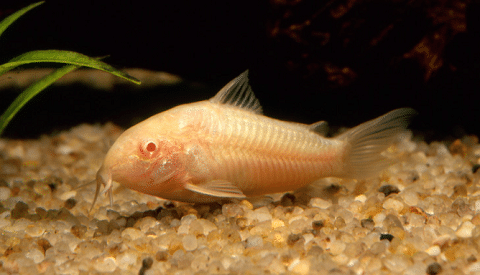
- Scientific Name: Corydoras sp.
- Difficulty Level: Easy to moderate
- Temperament: Peaceful
- Adult Size: 1-4 inches
- Minimum Tank Size: 10 gallons
- Origin: South America
- Diet: Omnivore
- pH: 6.0-8.0
- Temperature: 72-79° F
- Planted Tank Suitability? Yes
- Difficulty to breed: Moderate
Look at the bottom of any planted aquarium and you’re likely to see a school of cory catfish scuttling their way across the sand substrate. These schooling fish excel in a planted aquarium where they can dig around the substrate, eating detritus and other leftover food.
While cories are peaceful fish that like to explore, they can also be shy. During these times, you may see your foreground plants moving as your fish stay in the coverage of the vegetation.
2. Neon Tetra
Use Promo Code ASDFLIPPROMO
One of the most popular freshwater community schooling fish available in the aquarium trade. Great neon blue colors!
- Scientific Name: Paracheirodon innesi
- Difficulty Level: Easy
- Temperament: Peaceful
- Adult Size: 1.0-1.5 inches
- Minimum Tank Size: 10 gallons
- Origin: Amazon basin
- Diet: Omnivore
- pH: 5.0-7.0
- Temperature: 72–78 °F
- Planted Tank Suitability? Yes
- Difficulty to breed: Moderate to difficult
Neon tetras are a staple of the freshwater aquarium hobby. Something about their simple colors against a dense backdrop of dark green has won the hearts of aquarium keepers at all levels.
Generally considered a beginner fish, a school of neon tetras can bring additional color to the planted aquarium without any worry that these schooling fish will eat or disrupt the plants. While considered a small and skittish fish, neon tetras will happily and boldly swim in front of an exceptional aquascape.
3. Cardinal Tetra
A very popular schooling fish. Looks like the Neon Tetra, but with longer blue and red stripes. Grows larger than a neon tetra as well
- Scientific Name: Paracheirodon axelrodi
- Difficulty Level: Moderate
- Temperament: Peaceful
- Adult Size: 1.0-1.5 inches
- Minimum Tank Size: 10 gallons
- Origin: Orinoco and Negro Rivers
- Diet: Omnivore
- pH: 5.5-7.5
- Temperature: 72–82 °F
- Planted Tank Suitability? Yes
- Difficulty to breed: Difficult
The cardinal tetra is nearly identical to neon tetras but requires slightly more preferred water conditions. This makes them especially favorable for planted aquariums that have greater stability and water quality.
Cardinal tetras are usually preferred over neon tetras due to their brighter colorations and slightly stockier build.
4. Harlequin Rasbora
A peaceful schooling fish. An ideal community fish. A great beginner fish
- Scientific Name: Trigonostigma heteromorpha
- Difficulty Level: Easy
- Temperament: Peaceful
- Adult Size: 2 inches
- Minimum Tank Size: 10 gallons
- Origin: Southeast Asia
- Diet: Omnivore
- pH: 6.0-6.5
- Temperature: 72-78° F
- Planted Tank Suitability? Yes
- Difficulty to breed: Difficult
The harlequin rasbora isn’t seen in many aquariums despite its simple coloration and unique body shape. Harlequin rasboras do just as well in planted aquariums as they do in regular setups, but can bring an accent of color to other more colorful featured fish.
5. Chili Rasbora
Use Promo Code ASDFLIPPROMO
A great nano schooling fish. Males display brighter colors. Best in groups of 6 or more
- Scientific Name: Boraras brigittae
- Difficulty Level: Moderate
- Temperament: Peaceful
- Adult Size: 1 inch
- Minimum Tank Size: 5 gallons
- Origin: Southern Borneo, Indonesia
- Diet: Omnivore
- pH: 4.0-7.0
- Temperature: 68-82° F
- Planted Tank Suitability? Yes
- Difficulty to breed: Easy
Chili rasboras, also known as mosquito rasboras, are one of the smallest fish in the aquarium hobby and also one of the most expensive (video source). These fish are extremely popular for a nano-planted aquascape but relatively difficult to keep due to their size and need for more perfect water parameters. They are also very prone to jumping out of the aquarium, making a hood or other cover crucial for their survival.
Otherwise, these small fish are fascinating to watch school at the top layer of a nano tank. Once comfortable, they will readily spawn.
6. Betta Fish
Use Coupon Code ASDFISH at Checkout
Betta Fish are one of the most beautiful varieties of freshwater fish available in the hobby. Easy to care for with plenty of varieties!
- Scientific Name: Betta splendens
- Difficulty Level: Easy
- Temperament: Aggressive
- Adult Size: 2.5 inches
- Minimum Tank Size: 5 gallons
- Origin: Southeast Asia
- Diet: Omnivore
- pH: 6.5-8.0
- Temperature: 78-82° F
- Planted Tank Suitability? Yes
- Difficulty to breed: Moderate
For a long time, betta fish have been wrongly kept in small bowls of uncycled water without any filtration. When in reality, betta fish come from heavily planted ecosystems where they mingle in the vegetation.
Betta fish are another great nano option for small planted tanks, bringing extreme color to a small space. However, betta fish are aggressive fish to their own kind and those that look like them, which means that they are limited in tank mates.
7. White Cloud Minnows
A very peaceful fish that does well in coldwater fish. Other minnow varieties are also available
- Scientific Name: Tanichthys albonubes
- Difficulty Level: Easy
- Temperament: Peaceful
- Adult Size: 1.5 inches
- Minimum Tank Size:
- Origin: China and Vietnam
- Diet: Omnivore
- pH: 6.5-7.5
- Temperature: 64-72° F
- Planted Tank Suitability? Yes
- Difficulty to breed: Easy
White cloud minnows may be plain in color but they make up for it in activity level. These schooling fish love to swim at the top of the community fish tanks and will dart back and forth under a cover of floating aquarium plants.
White cloud minnows can bring a unique experience to the freshwater planted aquarium due to being a coldwater species. This can open up many different plant options to hobbyists who might be tired of keeping the typical tropical species.
8. Endler’s Livebearer
A very active and colorful livebearer. Smaller in size than guppies
- Scientific Name: Poecilia wingei
- Difficulty Level: Easy
- Temperament: Peaceful
- Adult Size: 1 inch
- Minimum Tank Size: 1o gallons
- Origin: Venezuela
- Diet: Omnivore
- pH: 5.5-8.0
- Temperature: 64-82° F
- Planted Tank Suitability? Yes
- Difficulty to breed: Easy
If guppies are the perfect starting fish for beginner tanks then Endler’s livebearers are the best starting fish for planted tanks. Endler’s livebearers are considered to be glorified guppies. Closely related, these two fish have almost the exact same care requirements.
Endler’s livebearers are considered to have more interesting shapes and patterns that can quickly fill a planted aquascape. By this, we mean that you need to be careful of their rapid reproductive rates!
9. Cherry Barbs
- Scientific Name: Puntius titteya
- Difficulty Level: Easy to moderate
- Temperament: Peaceful
- Adult Size: 2 inches
- Minimum Tank Size: 25 gallons
- Origin: Sri Lanka
- Diet: Omnivore
- pH: 7.2 – 7.5
- Temperature: 72-82° F
- Planted Tank Suitability? Yes
- Difficulty to breed: Easy
Cherry barbs are one of the most popular fish for planted aquariums and are rarely seen in a regular setup. These bright orange fish aren’t necessarily difficult to keep, but they much prefer having a natural setup with stable water conditions.
Even in the planted aquarium, cherry barbs can be shy so it’s important to keep them in appropriately-sized schools. They are very peaceful and great additions for community tanks.
10. Rummynose Tetra
An easy to care for Tetra fish that loves to school. Very peaceful fish that are great for beginners
- Scientific Name: Hemigrammus rhodostomus
- Difficulty Level: Moderate
- Temperament: Peaceful
- Adult Size: 1.5 inches
- Minimum Tank Size: 20 gallons
- Origin: South America
- Diet: Omnivore
- pH: 6.5-7.0
- Temperature: 75-84° F
- Planted Tank Suitability? Yes
- Difficulty to breed: Moderate
The rummynose tetra is a peaceful fish that can bring tons of activity to the middle and top layers of the aquarium. These fish are simple in coloration but adored for their signature red bodies.
While a smaller fish, rummynoses can be a great addition to a tank that features bigger, slower-moving species.
11. Siamese Algae Eater
A great algae-eating fish that is known for eating black beard algae. Grows up to 7 inches in length and requires a larger aquarium
- Scientific Name: Crossocheilus siamensis
- Difficulty Level: Moderate
- Temperament: Peaceful
- Adult Size: 6 inches
- Minimum Tank Size: 30 gallons
- Origin: India, Indonesia, Thailand
- Diet: Omnivore
- pH: 6.5-7.0
- Temperature: 75-79° F
- Planted Tank Suitability? Yes
- Difficulty to breed: Extremely difficult
Siamese algae eaters are a widely available and popular addition to the planted freshwater aquarium. However, they can grow to large sizes and need to be kept in groups, making them more demanding than some of the other fish on this list.
Despite their tank size requirements, siamese algae eaters are very efficient at safely removing algae from aquarium plants, including the dreaded black beard species.
12. Black Neon Tetra
A variant neon variety. More reliant than neon and cardinal tetras
- Scientific Name: Hyphessobrycon herbertaxelrodi
- Difficulty Level: Easy
- Temperament: Peaceful
- Adult Size: 1.5 inches
- Minimum Tank Size: 10 gallons
- Origin: South America
- Diet: Omnivore
- pH: 5.5-7.0
- Temperature: 72-77° F
- Planted Tank Suitability? Yes
- Difficulty to breed: Easy to moderate
The black neon tetra is a less popular type of schooling fish due to the popular demand for neon tetras. However, a school of black neon tetras can create a beautiful contrast with other fish in the aquarium against a dark green backdrop.
In general, black neon tetras are a little easier to breed than neon tetras.
13. Celestial Pearl Danio
A great-looking danio fish. Males are more colorful than females. A midway dwelling fish
- Scientific Name: Danio margaritatus
- Difficulty Level: Moderate
- Temperament: Peaceful
- Adult Size: 1.5 inches
- Minimum Tank Size: 10 gallons
- Origin: Myanmar/Southeast Asia
- Diet: Omnivore
- pH: 6.5 to 7.5
- Temperature: 72-76° F
- Planted Tank Suitability? Yes
- Difficulty to breed: Easy
Celestial pearl danios are beautiful fish that bring a very natural addition to the freshwater aquarium with their trout-like appearance. These schooling fish are very small and tend to be shy and should always be kept in groups.
Tanks should be set up keeping the celestial pearl danio in mind. They will need plenty of plants and driftwood to feel comfortable at all times.
14. Dwarf cichlids

- Scientific Name: Apistogramma spp., Mikrogeophagus spp.
- Difficulty Level: Easy to difficult
- Temperament: Semi-aggressive
- Adult Size: <5 inches
- Minimum Tank Size: 10 gallons
- Origin: South America
- Diet: Omnivore
- pH: 6.0-8.0
- Temperature: 72-82° F
- Planted Tank Suitability? Yes
- Difficulty to breed: Easy
Dwarf cichlids make the perfect feature fish for a planted aquarium. These fish bring incredible colors to the aquarium that small fish lack. Species of dwarf cichlid are especially popular among hobbyists looking to breed freshwater fish as they exhibit unique spawning characteristics and readily breed once comfortable.
15. Otocinclus
A small algae-eating fish. Also great with freshwater shrimp.
- Scientific Name: Otocinclus spp.
- Difficulty Level: Moderate to difficult
- Temperament: Peaceful
- Adult Size: 2-4 inches
- Minimum Tank Size: 20 gallons
- Origin: South America
- Diet: Herbivore
- pH: 6.8-7.5
- Temperature: 74-79°F
- Planted Tank Suitability? Yes
- Difficulty to breed: Difficult
In theory, the otocinclus is the perfect schooling fish for the planted aquarium. These smaller fish are small, friendly, and incredibly efficient at cleaning algae. The problem is that otos rely on the natural algae that are already available in the aquarium to survive and should only be kept in mature setups.
Another problem with otocinclus catfish is that they are difficult to breed in captivity. This means that almost all individuals available in the aquarium hobby are wild-caught, which can make the transition from the wild to the home aquarium difficult.
Other Fish To Consider
These fish didn’t make the top of the list as they have more advanced requirements. However, they also make great additions.
- Discus Fish
- Dwarf Gouramis like the Honey Gourami
- Freshwater Shrimp
- Algae Eating Snails like Nerites and pest removing snails like Assassin snails
Final Thoughts
Planted tanks might seem difficult at first, but they offer many benefits to fish and invertebrates. Many of the aquascaping fish recommended for these tanks are small and colorful, though a few featured species are larger and can fill up empty space.
Just make sure that a species is 100% plant-friendly or you will end up with nibbled-on leaves!
- About the Author
- Latest Posts
I’m thrilled that you found Aquarium Store Depot! Here you’ll find information on fish, aquariums, and all things aquatics related. I’m a hobbyist (being doing this since I was 11) and here to help other hobbyists thrive with their aquariums! I adhere to a high quality Editorial Process and Review products with real life field usage and practical analysis.



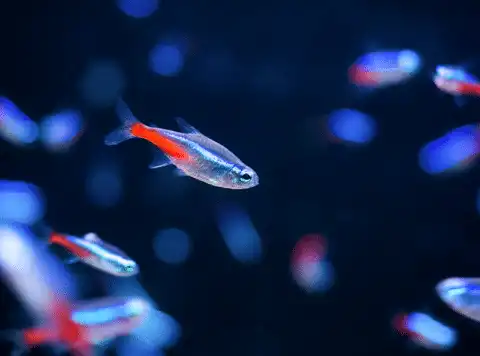

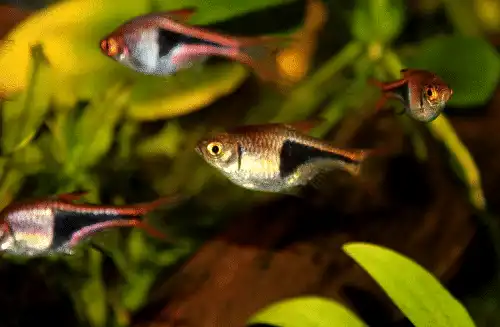
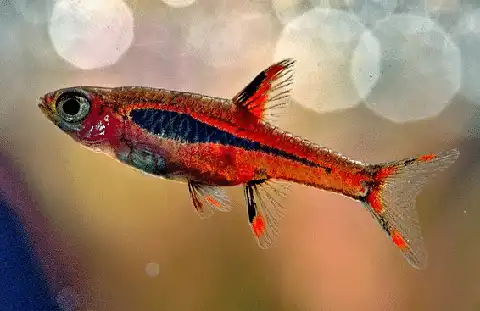
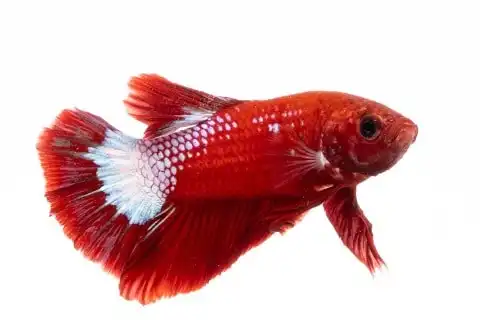



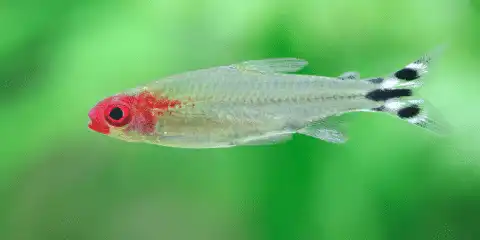
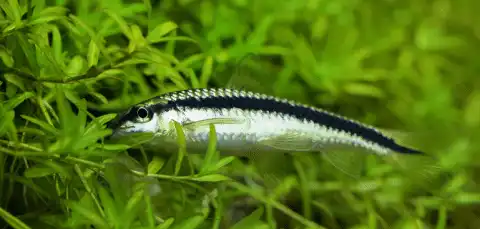
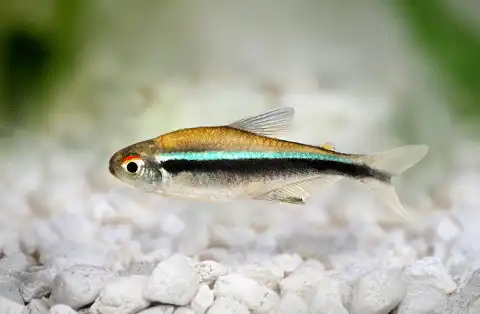
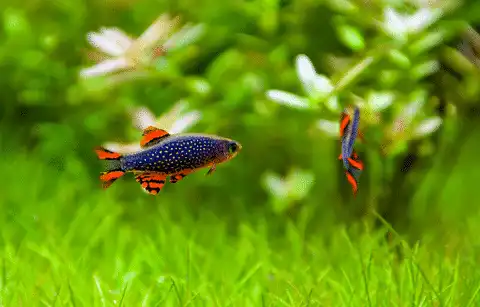
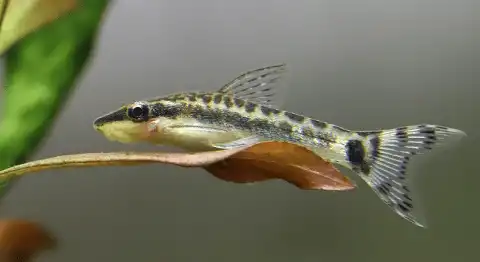




Thank you so much for this detailed info. Can I keep Angelfish in planted tank. I am currently moving to planted set up. Have 2 big black marbles and 2 white ones. Please suggest. Thanks & Regards
Hi there. Yes, you totally can keep Angelfish in a planted tank. I’d recommend getting a 4 foot long tank if you going to try it.